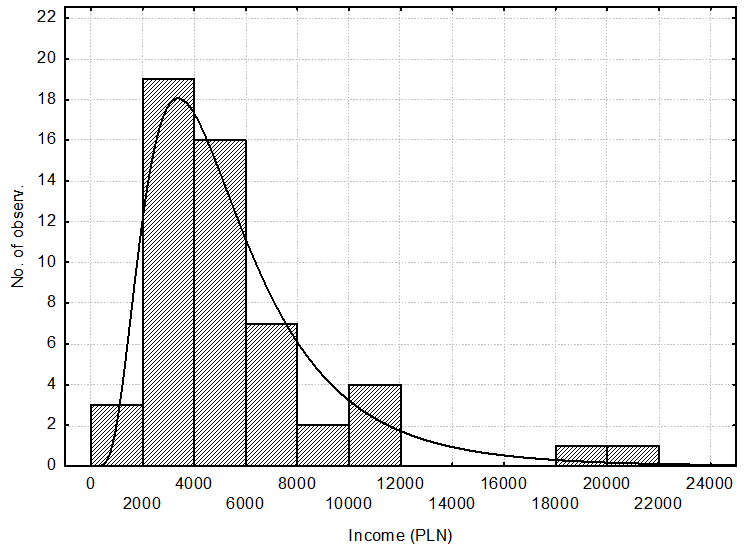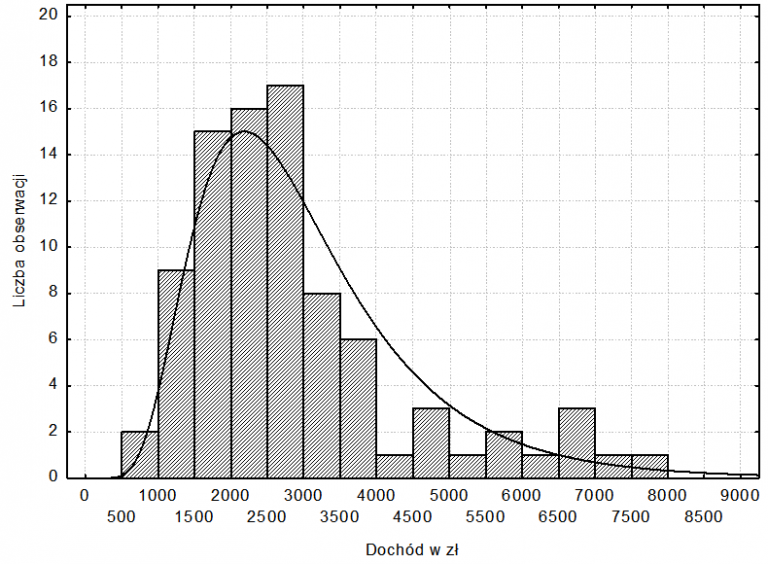During a survey, which was designed to provide a deeper analysis of issues addressed by the BADGE project (Business Advice and Guidance training for women Entrepreneurs. Project funded by the European Commission, as a part of Leonardo da Vinci – Transfer of Innovation programme), 150 respondents were asked about their income. The group included both women entrepreneurs (53 respondents) and women who do not plan starting their business (91 respondents). The average income of the women who do not plan becoming entrepreneurs was more than 2600zł lower than the average income of women entrepreneurs (Table 1).
Table 1. Descriptive statistics for the distribution of income in both groups of women
| Me | Mo | Q1 | Q3 | Q1-Q3 | ζ | ||
| Non-entrepreneurs | 3041 | 2600 | 2500 | 2000 | 3500 | 1500 | 167 |
| Entrepreneurs | 5698 | 4700 | 5000 | 3000 | 6791 | 3791 | 554,1 |
| 1st decile | 9th decile | V | ϭ2 | ϭ | A | K | |
| Non-entrepreneurs | 1500 | 5500 | 50,9 | 2399744 | 1549,1 | 1,4 | 1,7 |
| Entrepreneurs | 2500 | 11000 | 70,8 | 16273670 | 4034,1 | 2,2 | 5,9 |
Labels: in the article, the following designations have been adopted for the description of the discussed numbers: – average income, Me – median, Mo – mode, Q1 – first quartile, Q3 – third quartile, ζ – error, V – variation coefficient, ϭ2 – variance, ϭ – standard deviation, A – asymmetry coefficient, K – kurtosis coefficient
Source: Own compilation based on the results of the research.
The income median, so the middle value was over 2000zł higher in the group of women entrepreneurs. The income value declared the most (mode) in the group of women not running a business was 2500zł, while in the group women entrepreneurs – this value was double. Analysis of the first and third quartile and the difference between them indicates a wide variety and range of income among women entrepreneurs. The difference between quartiles in this case is twice as high in comparison to women who do not plan setting up their own business. Analysis of the deciles indicates that the value of income in 10% of households in both surveyed groups was 500zł lower than the first quartile. The difference between the third quartile and the tenth decile in both groups is not as consistent and equals: 2000zł for non-entrepreneurs, and more than 4200zł for women entrepreneurs. This means a large difference of in income among the members of the latter group. This is further confirmed by standard deviation value (σ), which is more than 2.5 higher for women entrepreneurs. The value of the variation coefficient (V) indicates that in both groups income diversity is statistically significant (>10%). The asymmetry coefficient of the income distribution (A) for women entrepreneurship is almost twice as high than in the case of women who do not plan becoming entrepreneurs. It means greater asymmetry of income distribution in this group, though in both cases the asymmetry is right-handed. The last key descriptive parameters of income distribution in the groups, kurtosis coefficient, indicates a greater concentration of income among women entrepreneurs. This is also confirmed and visible on the charts representing the distribution in both groups (Charts 1 and 2).
Chart 1. The distribution of income among women not planning to set up a business

Source: Own compilation based on the results of the research.
Chart 2. Distribution of income among women entrepreneurs

Source: Own compilation based on the results of the research.
A distribution of income simulation for both studied groups was performed using a two-parameter log-normal distribution, which is most often used in the case of income distribution analysis (Kot, 1999, p. 41), and its function of density is expressed by the formula:
 (1)
(1)
In the case of income distribution of women non-entrepreneurs the highest percentage of observed income landed between 2500 and 3000zł (19.7% observations). The income reaching this value accounted for 68,6% of total observations (median was established at around 2600zł).
In the case of income distribution of women entrepreneurs the highest percentage of observed income landed between 2000 and 4000zł (35.8% observations). This income range accounted for 41,5% of total observations (median was established at 4700zł).
The analysis of the distribution in both groups shows that women entrepreneurs are more likely to generate high income than women who do not plan starting up a business.
Footnotes:
Kot S.M. (red.), 1999, Analiza ekonometryczna kształtowania się płac w Polsce w okresie transformacji, Wydawnictwo Naukowe PWN, Warszawa-Kraków.

